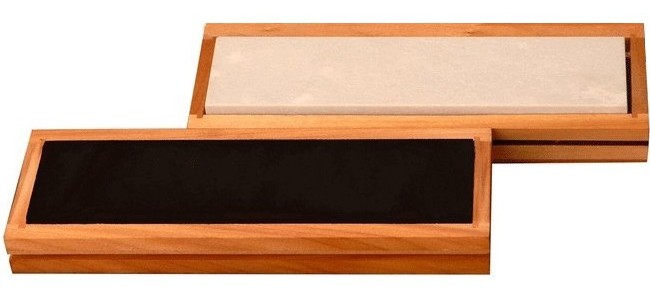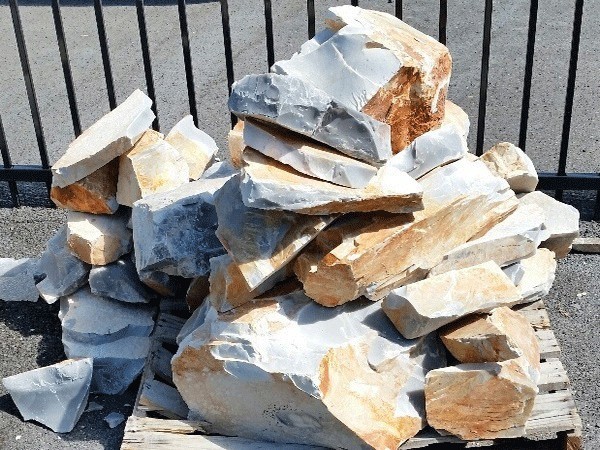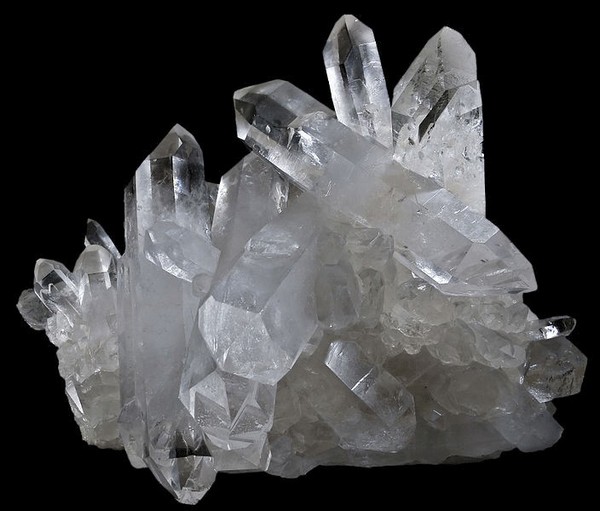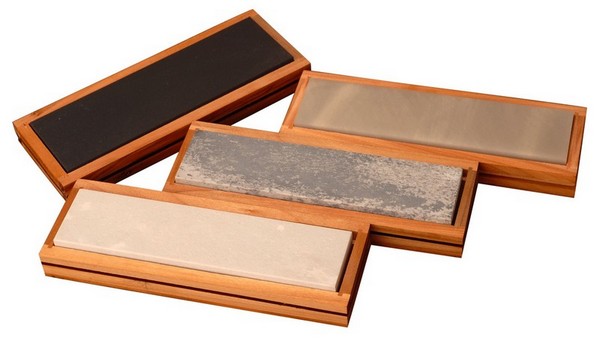Arkansas Stones FAQ

What is an Arkansas Stone?
Arkansas Stones are a natural sharpening stone mined only in the Ouachita Mountains of Arkansas. They are mined by blasting and the use of diamond saws. They are then cut into rectangular shapes to be used for sharpening knives and tools.
Arkansas Stones are also called Arkansas Sharpening Stones and Arkansas Whetstones. The terms Arkansas Stone, Arkansas Sharpening Stone and Arkansas Whetstone are interchangeable. They have the same meaning.

Novaculite is a rock that is comprised of quartz crystals. Quartz is a mineral made of the compound Silicone Dioxide (SiO2). Quartz is hexagonal in shape and has sharp edges. These sharp edges give Arkansas stones their unique sharpening abilities.

Arkansas Stones are made of a specific grade of novaculite. Not all novaculite is of a high enough quality to be used for sharpening stones. To be used for sharpening stones, the quartz must be composed of greater than 99% pure silicone dioxide. The novaculite that is used to make sharpening stones is called “Arkansas Novaculite”.
The term Arkansas Novaculite was first used in 1892 by geologist L.S. Griswold in his report entitled, Whetstones and the Novaculites of Arkansas. He documented this specific grade of novaculite and called it Arkansas Novaculite.[5] This is the form of Novaculite used for making Arkansas Stones.
Novaculite outcrops can also be found in in Eastern Oklahoma and west Texas. The novaculite found in Oklahoma and Texas is not the same quality as Arkansas Novaculite. The Texas outcrops are part of the Caballos Novaculite, rather than the Arkansas Noviculite.
Where do Arkansas Stones come from?
Arkansas Stones are a natural stone mined only in the Ouachita Mountains of Southwest Arkansas, USA. Arkansas Sharpening Stones come from area that is approximately 50 miles in radius.
What are the types of Arkansas Stones?

Arkansas stones have a variety of colors including white, off-white, gray, brown, black, blue-black, pink, red, orange and occasionally purple. The color variation comes from trace minerals dispersed throughout the rock. Many of the same colors exist in more than one grade of stone. Color is used to help grade stones but it does not distinguish grit.
What is Specific Gravity?
Specific Gravity is defined as the ratio of the density of a material to the density of water. Density is a measure of how compact or heavy the material is. Specific gravity testing is used to determine the density of Arkansas Stones. This density is used to classify Arkansas Stones into the four types: Soft, Hard, Black and Translucent.
What is the density of the four grades of Arkansas stones?
Soft: 2.25 to 3.0, Hard: 2.30 to 2.45, Black: 2.50+, Translucent: 2.50+
What grit are Arkansas Stones?
To see how we determine the grits click here - Arkansas Sharpening Stone Grits
Arkansas Stones Oil or Water?
We recently spent some time testing this. You can use either water or oil with Arkansas sharpening stones. A light mineral oil is preferred by most users. It does a better job of preventing the stones from clogging. Water is thinner than oil. It will sink in to the cavities of the stones more quickly so you will have to add it more frequently (similar to using a water stone).
Why do my new stones feel rougher than my old ones?
All Arkansas stones are finished on a lapidary wheel. When the quarry makes a stone they use an approximately 200 grit abrasive to shape and flatten the stone. After a little use the 'roughness' caused by the lapidary machine disappears leaving the natural grit of the stone and your new stone will feel smoother.
How do you clean Arkansas Stones?
Regardless of the lubricant you choose, Arkansas stones should be cleaned after each use by putting lubricant on the stone, rubbing it around and then wiping the excess lubricant away with a clean cloth. If you’re sharpening with oil then use whatever oil you are using as a lubricant. If you’re using water then soapy water, Krud Kutter or an all purpose cleaner should be used to clean the stone.
Are Arkansas stones “extinct”?
No. This fallacy falls under “heard it on the internet”. There are literally mountains of it. The amount of novaculite that exists in the Ouachita Mountains will allow for the continued production of Arkansas sharpening stones for the indefinite future.
Are Novaculite and Arkansas Stone the same thing?
No, the terms Novaculite and Arkansas Stones are not interchangeable. I have seen this phrase repeatedly; “Novaculite, also called Arkansas Stone”. That is false. Many online resources have it wrong. Even Wikipedia has it wrong. In fact, much of the information in this Wikipedia article is wrong.
It is like saying “a rifle is also called Remington”. Not all rifles are Remington and not all novaculite is used to make Arkansas Stones. The Novaculite that is used to make Arkansas stones comes from a small area of Southwest Arkansas and it has very specific properties.
What are some other interesting things about Arkansas Stones?
The history of the use of Arkansas Novaculite is amazing. Novaculite was used by people living in the Ouachita Mountains at least as far back as 6000 BC.
It is considered by historians as “the stone that built America” and it remains one of the most popular types of sharpening stones used worldwide.
Arkansas Stones are a natural sharpening stone mined only in the Ouachita Mountains of Arkansas. They are mined by blasting and the use of diamond saws. They are then cut into rectangular shapes to be used for sharpening knives and tools.
Arkansas Stones are also called Arkansas Sharpening Stones and Arkansas Whetstones. The terms Arkansas Stone, Arkansas Sharpening Stone and Arkansas Whetstone are interchangeable. They have the same meaning.

Arkansas Novaculite ready for processing
What is Novaculite? Novaculite is a rock that is comprised of quartz crystals. Quartz is a mineral made of the compound Silicone Dioxide (SiO2). Quartz is hexagonal in shape and has sharp edges. These sharp edges give Arkansas stones their unique sharpening abilities.

Quartz Crystal Cluster
What is the difference between Novaculite and Arkansas Stones? Arkansas Stones are made of a specific grade of novaculite. Not all novaculite is of a high enough quality to be used for sharpening stones. To be used for sharpening stones, the quartz must be composed of greater than 99% pure silicone dioxide. The novaculite that is used to make sharpening stones is called “Arkansas Novaculite”.
The term Arkansas Novaculite was first used in 1892 by geologist L.S. Griswold in his report entitled, Whetstones and the Novaculites of Arkansas. He documented this specific grade of novaculite and called it Arkansas Novaculite.[5] This is the form of Novaculite used for making Arkansas Stones.
Novaculite outcrops can also be found in in Eastern Oklahoma and west Texas. The novaculite found in Oklahoma and Texas is not the same quality as Arkansas Novaculite. The Texas outcrops are part of the Caballos Novaculite, rather than the Arkansas Noviculite.
Where do Arkansas Stones come from?
Arkansas Stones are a natural stone mined only in the Ouachita Mountains of Southwest Arkansas, USA. Arkansas Sharpening Stones come from area that is approximately 50 miles in radius.
What are the types of Arkansas Stones?
Arkansas Stones come in four types or classifications - Soft, Hard, Black and Translucent.

Clockwise from bottom, Hard, Black, Translucent, Soft.
What colors are they? Arkansas stones have a variety of colors including white, off-white, gray, brown, black, blue-black, pink, red, orange and occasionally purple. The color variation comes from trace minerals dispersed throughout the rock. Many of the same colors exist in more than one grade of stone. Color is used to help grade stones but it does not distinguish grit.
What is Specific Gravity?
Specific Gravity is defined as the ratio of the density of a material to the density of water. Density is a measure of how compact or heavy the material is. Specific gravity testing is used to determine the density of Arkansas Stones. This density is used to classify Arkansas Stones into the four types: Soft, Hard, Black and Translucent.
What is the density of the four grades of Arkansas stones?
Soft: 2.25 to 3.0, Hard: 2.30 to 2.45, Black: 2.50+, Translucent: 2.50+
What grit are Arkansas Stones?
- Soft Arkansas - Grit Equivalent: 1200 | 12 micron | .00047"
- Hard Arkansas - Grit Equivalent: 1500 | 10-11 micron | .00041"
- Black Arkansas - Grit Equivalent: 2300-2500 | 7-7.5 micron | .00028"
- Translucent Arkansas - Grit Equivalent: 3500-4000 | 5.5-6 micron | .00023"
Arkansas Stones Oil or Water?
We recently spent some time testing this. You can use either water or oil with Arkansas sharpening stones. A light mineral oil is preferred by most users. It does a better job of preventing the stones from clogging. Water is thinner than oil. It will sink in to the cavities of the stones more quickly so you will have to add it more frequently (similar to using a water stone).
Why do my new stones feel rougher than my old ones?
All Arkansas stones are finished on a lapidary wheel. When the quarry makes a stone they use an approximately 200 grit abrasive to shape and flatten the stone. After a little use the 'roughness' caused by the lapidary machine disappears leaving the natural grit of the stone and your new stone will feel smoother.
How do you clean Arkansas Stones?
Regardless of the lubricant you choose, Arkansas stones should be cleaned after each use by putting lubricant on the stone, rubbing it around and then wiping the excess lubricant away with a clean cloth. If you’re sharpening with oil then use whatever oil you are using as a lubricant. If you’re using water then soapy water, Krud Kutter or an all purpose cleaner should be used to clean the stone.
Are Arkansas stones “extinct”?
No. This fallacy falls under “heard it on the internet”. There are literally mountains of it. The amount of novaculite that exists in the Ouachita Mountains will allow for the continued production of Arkansas sharpening stones for the indefinite future.
Are Novaculite and Arkansas Stone the same thing?
No, the terms Novaculite and Arkansas Stones are not interchangeable. I have seen this phrase repeatedly; “Novaculite, also called Arkansas Stone”. That is false. Many online resources have it wrong. Even Wikipedia has it wrong. In fact, much of the information in this Wikipedia article is wrong.
It is like saying “a rifle is also called Remington”. Not all rifles are Remington and not all novaculite is used to make Arkansas Stones. The Novaculite that is used to make Arkansas stones comes from a small area of Southwest Arkansas and it has very specific properties.
What are some other interesting things about Arkansas Stones?
The history of the use of Arkansas Novaculite is amazing. Novaculite was used by people living in the Ouachita Mountains at least as far back as 6000 BC.
It is considered by historians as “the stone that built America” and it remains one of the most popular types of sharpening stones used worldwide.
Here are a few resources about the history of Arkansas Novaculite from the Arkansas Archeological Survey.
“Archaic Arkansas” – The Jones Mill Archeological Project
Arkansas Novaculite and Quarries
Related Articles:
Arkansas Sharpening Stone Grits
What is an Arkansas Stone?
Arkansas Sharpening Stones for Sale
More Sharpening Articles
References:
1. Griswold, L. S., 1892, Whetstones and the novaculites of Arkansas: Arkansas Geological Survey Annual Report for 1890, v. III, 443 p.
2. Arkansas Geological Survey (formerly Arkansas Geological Commission) - Novaculite (Silica Stone)
3. Holbrook, D. F., and Stone C. G., 1978, Arkansas Novaculite – A silica resource, in Johnson, K. S. and Russell, J. A., eds., Thirteenth Annual Forum on the Geology of Industrial Minerals: Oklahoma Geological Survey Circular 79, p. 51-58.
4. H. Pennington, Encyclopedia of Arkansas - Novaculite
5. Arkansas Archeological Survey - Arkansas Archeological Survey 2016 "Arkansas Novaculite: A Virtual Comparative Collection.
“Archaic Arkansas” – The Jones Mill Archeological Project
Arkansas Novaculite and Quarries
Related Articles:
Arkansas Sharpening Stone Grits
What is an Arkansas Stone?
Arkansas Sharpening Stones for Sale
More Sharpening Articles
References:
1. Griswold, L. S., 1892, Whetstones and the novaculites of Arkansas: Arkansas Geological Survey Annual Report for 1890, v. III, 443 p.
2. Arkansas Geological Survey (formerly Arkansas Geological Commission) - Novaculite (Silica Stone)
3. Holbrook, D. F., and Stone C. G., 1978, Arkansas Novaculite – A silica resource, in Johnson, K. S. and Russell, J. A., eds., Thirteenth Annual Forum on the Geology of Industrial Minerals: Oklahoma Geological Survey Circular 79, p. 51-58.
4. H. Pennington, Encyclopedia of Arkansas - Novaculite
5. Arkansas Archeological Survey - Arkansas Archeological Survey 2016 "Arkansas Novaculite: A Virtual Comparative Collection.

